IN THIS ISSUE
- Special turtle, special place
- Bishopweed once lost, now found
- A wow bird in your backyard
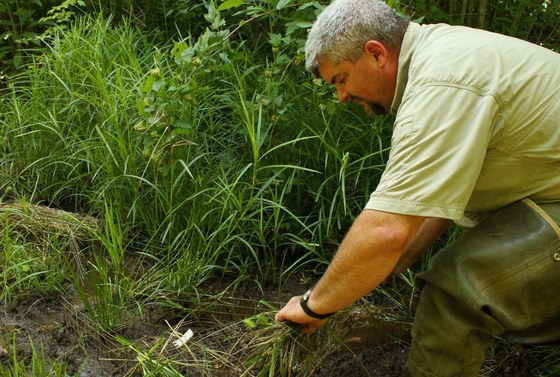 Thomas Floyd checks a turtle live trap at Brasstown Valley. (Josiah Lavender/DNR)
On a hot June afternoon in the woods at Brasstown Valley, Thomas Floyd spotted a legendary turtle.
Of course, not the great turtle that saved Native Americans from a flood, a legend woven into promotions of the Young Harris resort and spa. But something more fitting for Floyd’s work as a biologist with DNR’s Nongame Conservation Section:
A bog turtle surfaced in the muck. And only seconds after Floyd was being videoed about conserving the species.
“There’s a bog turtle!” he yelled, plunging an arm into the mud to grab the reptile before it burrowed back in.
Floyd checked the turtle’s markings – it was a female first documented by researchers in 2014 – and said with a wide smile, “This is the first time I’ve ever caught one like this!” (Watch the video.)
Bog turtles are North America’s smallest turtle and a species federally listed as threatened. They grow about 4½ inches long and live in the muck of mountain bogs, one of the Southern Appalachians’ most endangered habitats. The most significant threat facing bog turtles is habitat loss.
Floyd leads DNR efforts to monitor populations in northeast Georgia, the southern extreme of the species’ range. He and his techs live-trap, PIT-tag and often radio-track turtles to better understand them and their habitats (details in Nongame Conservation's annual report).
Historical data, computer modeling, aerial photos and weeks of legwork are used to search out new bog turtle sites. The state’s number of known populations is at 10, including three found since 2014.
Earlier on that June day, Floyd and techs Sarah Martin and Clay Trimmer had checked traps at a wetland framed by mountains in a Union County pasture, the most recently discovered site. The group also released a female turtle caught there the day before.
Although the traps were empty this time, the bog has yielded eight turtles -- six this year, four of which hadn't been caught before. Some were young females, signs of a reproducing population. Brasstown Valley holds promise, too, but more because it is state-owned and can be closely managed, the first DNR property with bog turtles.
Martin and Trimmer later continued on their daily 200-mile-loop to check other bogs, a seasonal circuit that ended last month. Floyd headed for Brasstown Valley, and a bog turtle surprise (photos from the day).
Back to top.
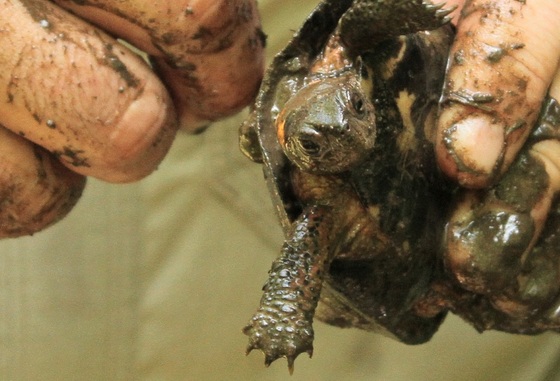 Brasstown Valley bog turtle. (Josiah Lavender/DNR)
DID YOU KNOW?
Bog turtles can breathe through their butts; or more technically, take in oxygen through their cloaca, a cavity inside the anus. This is helpful and even necessary for creatures that spend long periods of time buried in wet muck, including during hibernation. Some other turtles and other creatures, such as nymph dragonflies, share the ability. Listen to this podcast on cloacoal breathing.
HOW CAN YOU HELP
DNR’s Nongame Conservation Section depends largely on fundraisers, grants and contributions to conserve Georgia’s rare and other animal and plant species that aren’t legally hunted, fished for or collected. Our top fundraiser is the sale and annual renewal of the eagle and hummingbird license plates.
These tags not only look good on your car or truck, they show that you support wildlife. DNR plates cost only $25 more than a standard peach plate to buy or renew. And most of that fee goes to conserve animals, rare plants and habitats!
Back to top.
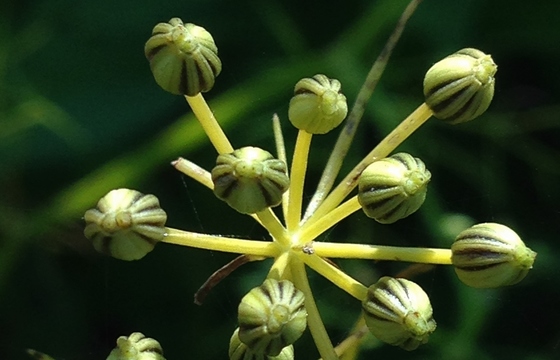 Carolina bishopweed with fruit. (April Punsalan/USFWS)
Carolina bishopweed may be, as DNR biologist Jacob Thompson says, an “unassuming plant.”
But after going missing in Georgia for a half-century, its recent re-discovery near the Savannah National Wildlife Refuge is raising eyebrows, and hopes of conserving this rare species.
Ptilimnium ahlesii is a member of the carrot family that favors the edges of tidal freshwater marshes, where its slender stalks and small white flowers are easily missed or confused with similar species. There’s no overlooking the plant’s at-risk status, however. Petitioned for Endangered Species Act listing, Carolina bishopweed has been documented only in the Carolinas and Georgia, and was considered extirpated in the latter.
“The last time it was found here was in 1966,” said Thompson, of the Nongame Conservation Section.
Considering the rarity, Thompson and intern Jessica Ahl checked the last-known Georgia location – a roadside close to the federal refuge and Port Wentworth – in May, when the species flowers.
Bingo. They found about 35 plants. The ID was confirmed through other botanists and a return visit with U.S. Fish and Wildlife Service staff Chuck Hayes, Billy Harris and April Punsalan in June, when the Ptilimnium ahlesii was setting fruit, a timing that further distinguishes it from more common species.
The State Botanical Garden of Georgia, a fellow member of the Georgia Plant Conservation Alliance, will try to grow the plants. If successful, those could be outplanted at Savannah NWR, boosting the profile and promise of a species long thought lost in this state.
 DNR and Fish and Wildlife Service staff monitor bishopweed. (April Punsalan/USFWS)
Back to top.
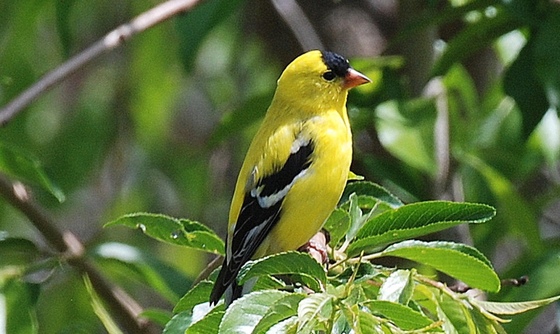 Male American goldfinch. (Terry W. Johnson)
By TERRY W. JOHNSON
Regaled in brilliant yellow and black breeding plumage, the male American goldfinch is a member of a select group of backyard birds I call wow birds.
They’re so stunning, the first time people see them, they often exclaim, "Wow!"
Throughout spring and summer, male American goldfinches are the only small yellow bird with a black cap, wings and tail that you’re likely to see in your yard. The rest of the year, the males look much like the females, which are olive-colored on the body and have dusky wings with two white wing bars.
During winter, flocks of American goldfinches congregate around feeders throughout the Peach State. However, during spring and summer only those of us who live from the Upper Coastal Plain north are likely to spot them. …
Read the rest of Terry’s column for tips on how to attract goldfinches to your yard, plus insights into why they’re nesting now.
Terry W. Johnson is a retired DNR nongame program manager and executive director of TERN, Nongame Conservation’s friends group. For more, check out the Out My Backdoor library and Terry’s blog, Backyard Wildlife Connection.
Back to top.
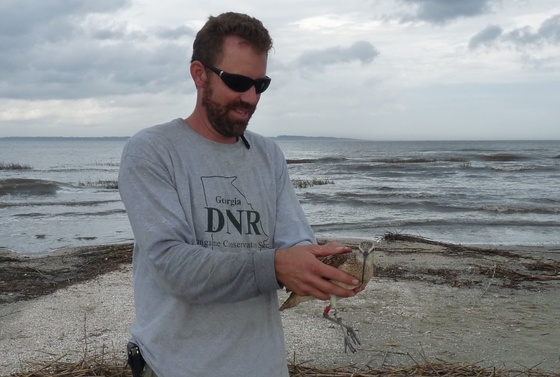 DNR's Tim Keyes with the curlew on Wolf Island NWR in December. (SMBC)
A long-billed curlew that migrated from Wolf Island National Wildlife Refuge to Saskatchewan last spring is back in Georgia, completing a round-trip of more than 5,000 miles. The curlew is being tracked by the Smithsonian Conservation Institute’s Migratory Bird Center and partners such as DNR to document breeding grounds and stopover sites used by the species’ shrinking Atlantic Coast population (“Following a ghost from the coast,” April 19).
’Seen the new Georgia Wild video series? OK, so there’s only one video so far, but Nongame Conservation Section Education Coordinator Linda May and Heidi Ferguson, social media coordinator for DNR’s Wildlife Resources Division, will soon post the second (hint: it’ll boost your appreciation or help overcome your fear of a certain reptile group). Stay tuned to Facebook!
The record 3,200-plus nests laid on Georgia beaches by loggerhead sea turtles are churning out hatchlings by the hundreds. More than an estimated 83,000 have emerged so far, a mean emergence success rate of 58 percent. Daily updates.
Third- through fifth-grade life sciences teachers and science specialists in Georgia can earn a $1,000 grant from DNR to help fund an innovative school project. The agency is again teaming with The Environmental Resources Network, or TERN, friends group of the Nongame Conservation Section, to award the Conservation Teacher of the Year grant. Applications are due by Sept. 19.
All outdoor enthusiasts who visit DNR wildlife management areas also need to know when an area is holding a hunt. Just out this month, the 2016-2017 Georgia Hunting Seasons and Regulations Guide is available online and in print at Wildlife Resources Division offices and licenses vendors.
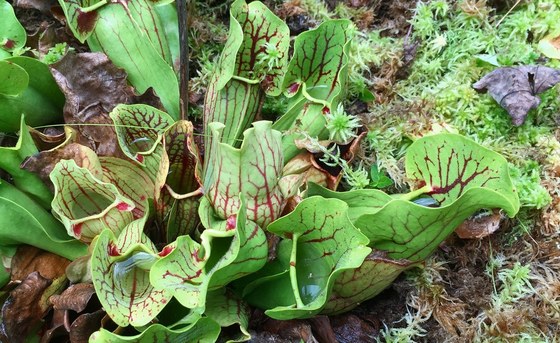 Mountain purple pitcherplants in north Georgia (Emily Ferrall/DNR)
The mountain purple pitcherplants above were photographed during a Georgia Plant Conservation Alliance work day at a Chattahoochee National Forest mountain bog. For these carnivorous plants, enzymes dissolved in water at the base of pitchers digest animals trapped there (see the insect in the center-bottom pitcher?). The animals provide nutrients for the plants, particularly nitrogen, which is typically low in the soils of bogs and other permanently saturated wetlands.
Invasive species will suffer and natives will prosper from downtown Atlanta to coastal Georgia thanks to this year’s Five Star and Urban Waters Restoration grants by Southern Co. and the National Fish and Wildlife Foundation. The eight habitat restoration projects chosen in Georgia, Florida and Alabama include Trees Atlanta replacing invasives with natives on 6 acres along Proctor Creek and Coastal Wildscapes and partners planting wetland species, adding stormwater controls and conducting outreach at a Cay Creek demonstration garden in Midway.
Georgia Ornithological Society is gearing up for its fall meeting on Jekyll Island Oct. 7-9. Activities vary from guided field trips along the coast to a keynote address by the Smithsonian Migratory Bird Center's Dr. Peter Marra, author of “Cat Wars.”
At Go Fish Education Center in Perry, outreach includes a Toad-ally Toddlers! program Aug. 26 focused on snakes – with four one-hour sessions planned – and a homeschool program for K-6th-grades September through May. The first topic up for homeschoolers is invertebrates, set for 9:30-11:30 a.m. Sept. 2 and 16.
If you like your tweets bundled, sign up for DNR Wildlife Resources Division’s free Twitter digest. Click the red envelope at www.georgiawildlife.com and select “@GeorgiaWild Twitter updates” under Wildlife Resources Division to get a week’s worth of news and insights sent to your inbox each Thursday.
Names in the news: Former DNR Wildlife Resources Division Director Dan Forster has been named director of government relations for the Archery Trade Association. Forster retired from DNR in July, leading to Rusty Garrison, previously manager of Charlie Elliott Wildlife Center, being appointed division director. Even at 90, former Board of Natural Resources member and Georgia first lady Betty Sanders continues to explore her fascination with the state’s natural resources through art. The wife of the late Gov. Carl Sanders, who refers to herself as Georgia’s “paintingest first lady,” also has been a strong supporter of Nongame Conservation Section’s annual Weekend for Wildlife fundraiser. The Association of Fish and Wildlife Agencies has hired Sean Saville as its campaign manager for the Blue Ribbon Panel on Sustaining America’s Diverse Fish and Wildlife Resources. Saville had been working as National Audubon Society’s field director. His focus will center on HR 5650, legislation advocated by the panel and aimed at steering $1.3 billion in fees already assessed for energy and mineral development on federal property to states and territories to conserve wildlife via State Wildlife Action Plans. While no action is expected this session on the “marker” bill, one used to introduce measures or issues into a larger debate, the hope is the next Congress takes it up (track the bill). Noted naturalist and archaeologist Frankie Snow is profiled in this blog post by Orianne Society’s Dirk Stevenson.
Back to top.
COMING UP
Aug. 13
– Sustainability Expo, Madison-Morgan Cultural Center, Madison
– Snake Day, Cochran Mill Nature Center, Chattahoochee Hills
Aug. 19-21 – Perry Buckarama, Georgia National Fairgrounds, Perry
Oct. 1 – CoastFest, DNR Coastal Regional Headquarters, Brunswick
Nov. 1-3 – Southeastern Partners in Plant Conservation, Atlanta Botanical Garden
WHAT YOU MISSED ...
In the previous Georgia Wild:
– Sea turtles reach a recovery benchmark
– DNR’s wild coloring book for kids
– Woodpecker revelation at Moody Forest
Back to top.
"Gone: The race to stop the fungus killing millions of bats," Atlanta Magazine. Related coverage: Georgia Public Broadcasting, motherboard.
"Science teachers eligible for grant through DNR," The (Macon) Telegraph, and others including Gwinnett Daily Post, Albany Herald and Augusta CEO.
"Garrison to focus on customer service as head of Wildlife Resources," Newtown Citizen
"Roman tracking turtles on Little Cumberland Island," Rome News-Tribune
"Cogongrass can be stopped," CompassLive USDA Southern Research Station
"Southern Co. to fund waterway conservation projects in Georgia," Atlanta Business Chronicle
"Buckarama celebrates 25th year," The (Macon) Telegraph
"Tracking kestrels one feather at a time," Audubon
"Big cats are rare in Georgia," ajc.com
"When it comes to West Nile Virus, Atlanta's cardinals may be feathered saviors," Smithsonian
"Red drum on new Georgia plate to enhance marine habitat," Florida Times-Union
"Give (beach) nesting birds their space," Georgia Magazine. Also: "Get back to nature at Charlie Elliott Wildlife Center."
“UGA Press publishes user's guide for Broad River,” Athens Banner-Herald
"DNA study reveals one, only wolf species in North America," The New York Times
"Scientists see birds sleep during flight for first time ever," Science Alert
"Hibernating toads reveal climate change clues," The Wildlife Society
"Two’s company, three’s a lichen?" The New York Times
"Wilderness, wildlife, bamboo and fossils: The Savannah you don't know," ajc.com
"State-federal land swap bill could aid conservation," The Wildlife Society
VIDEO AND AUDIO
"Georgia Wild: Hummingbirds," DNR
"Wildlife officials check turtle nests on Ossabaw Island," (click 1:48-minute video), WTOC-TV (Savannah)
"Watch this beautiful, chaotic bat ballet," Atlas Obscura
Also check out the online library of DNR wildlife videos.
Back to top.
Masthead image: bog turtle (Rick Lavender/DNR)
|